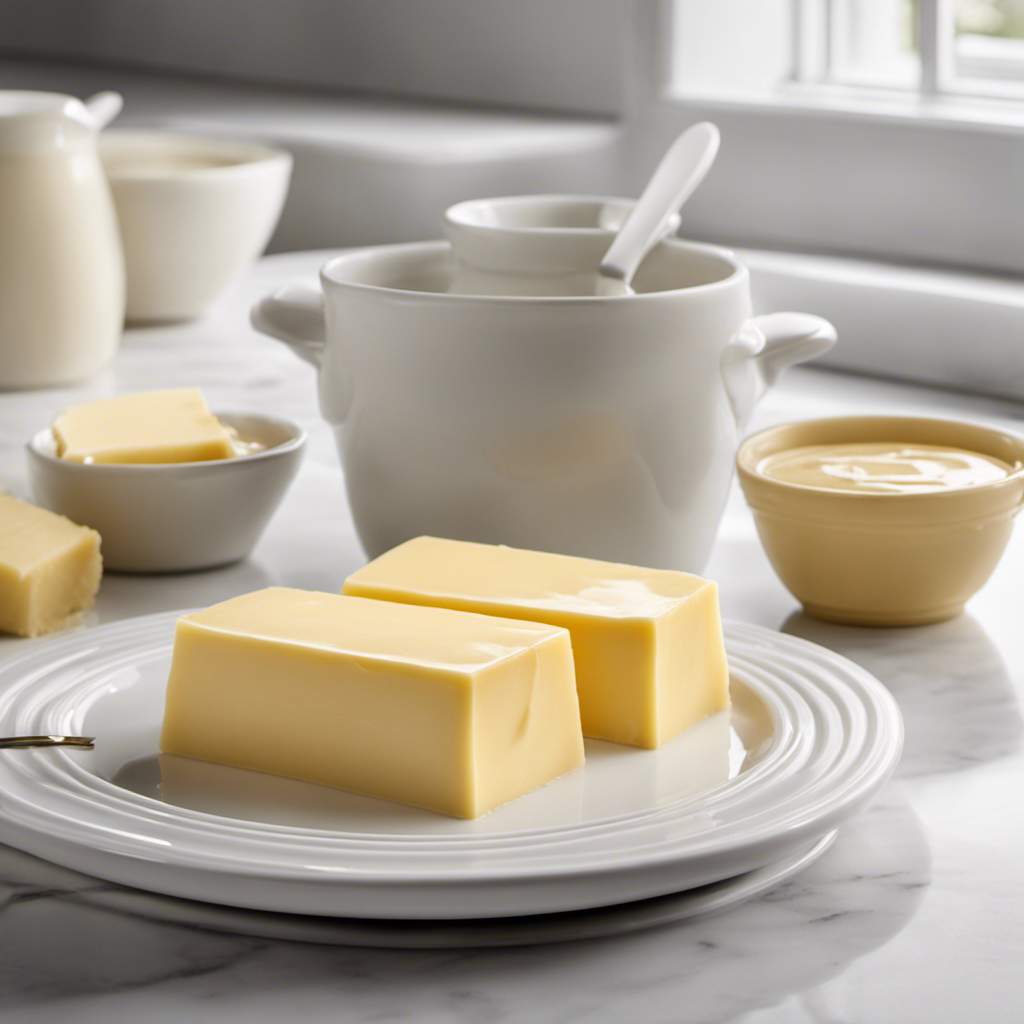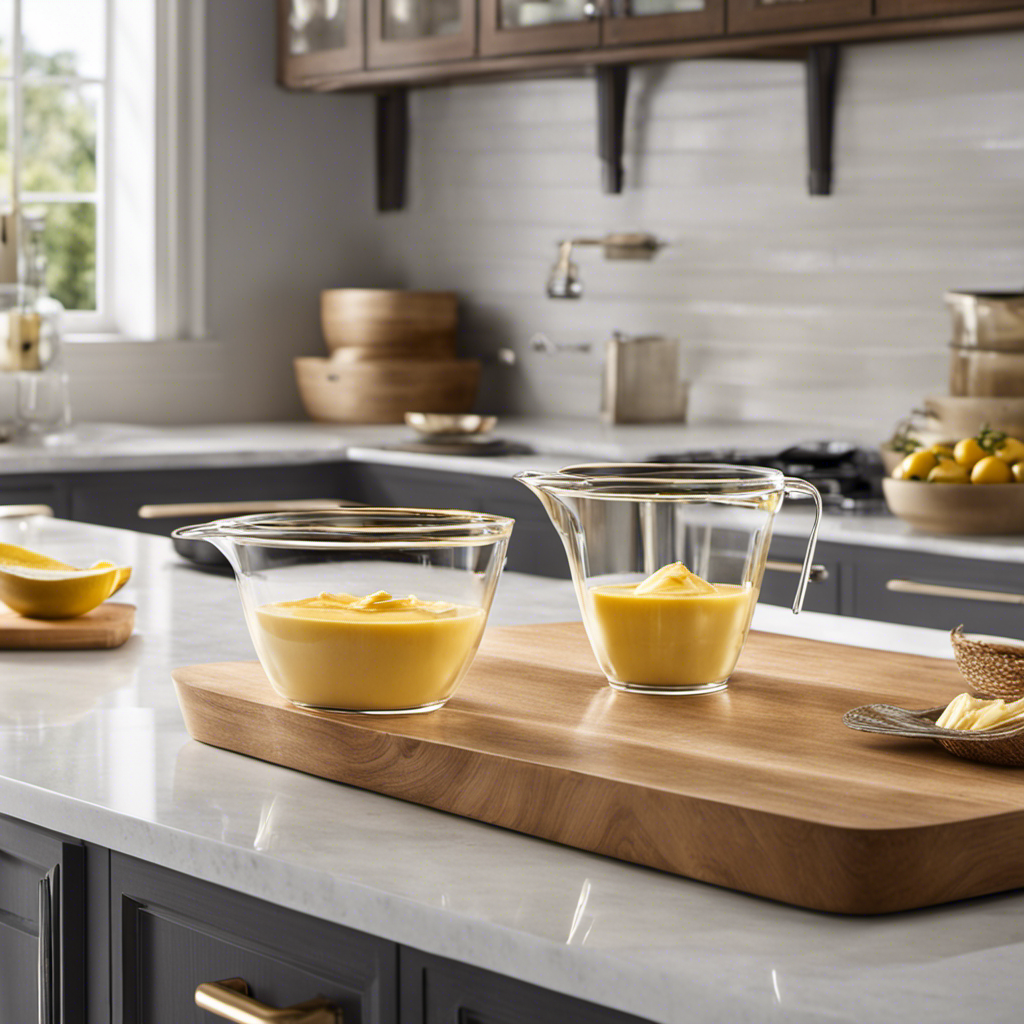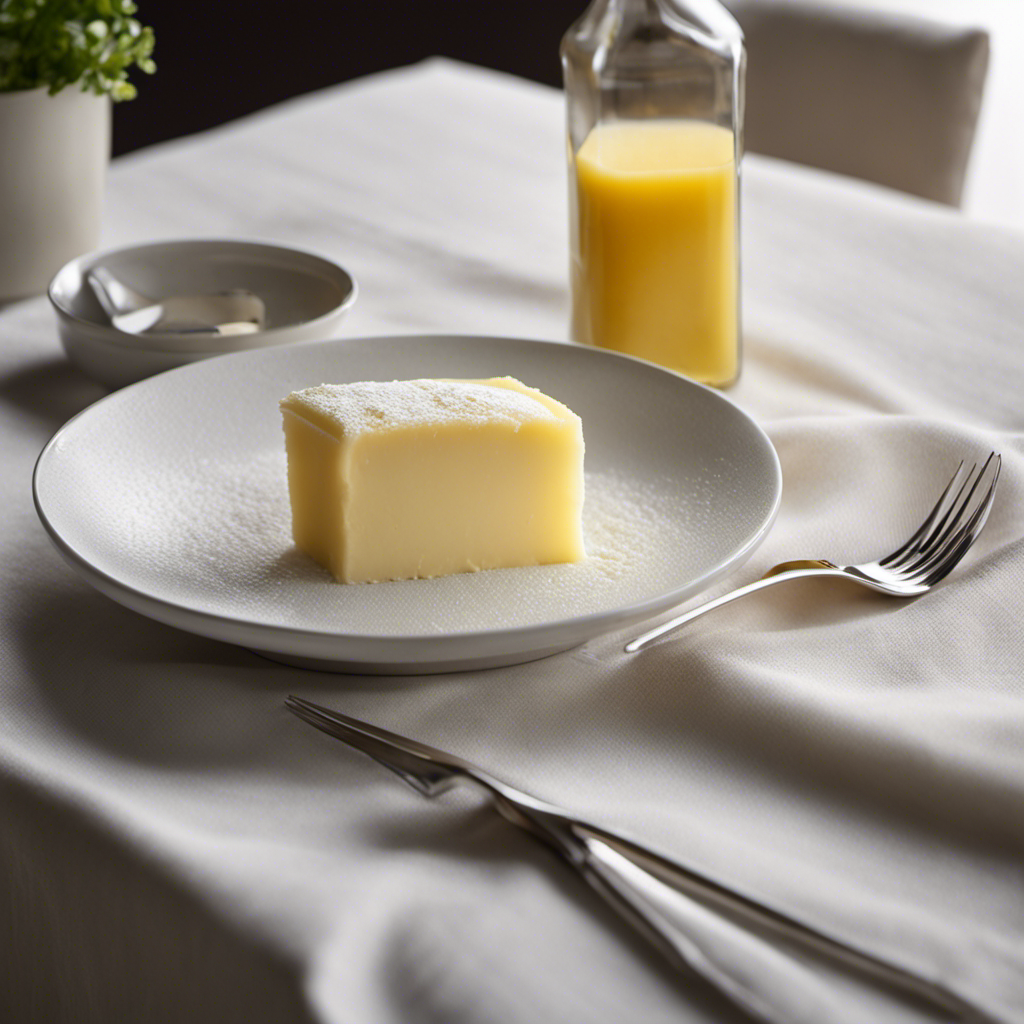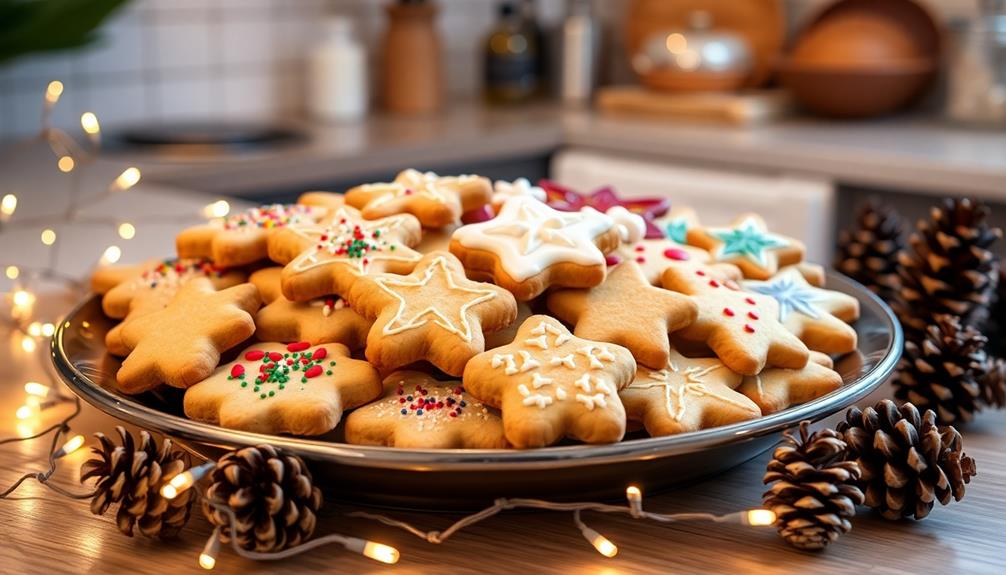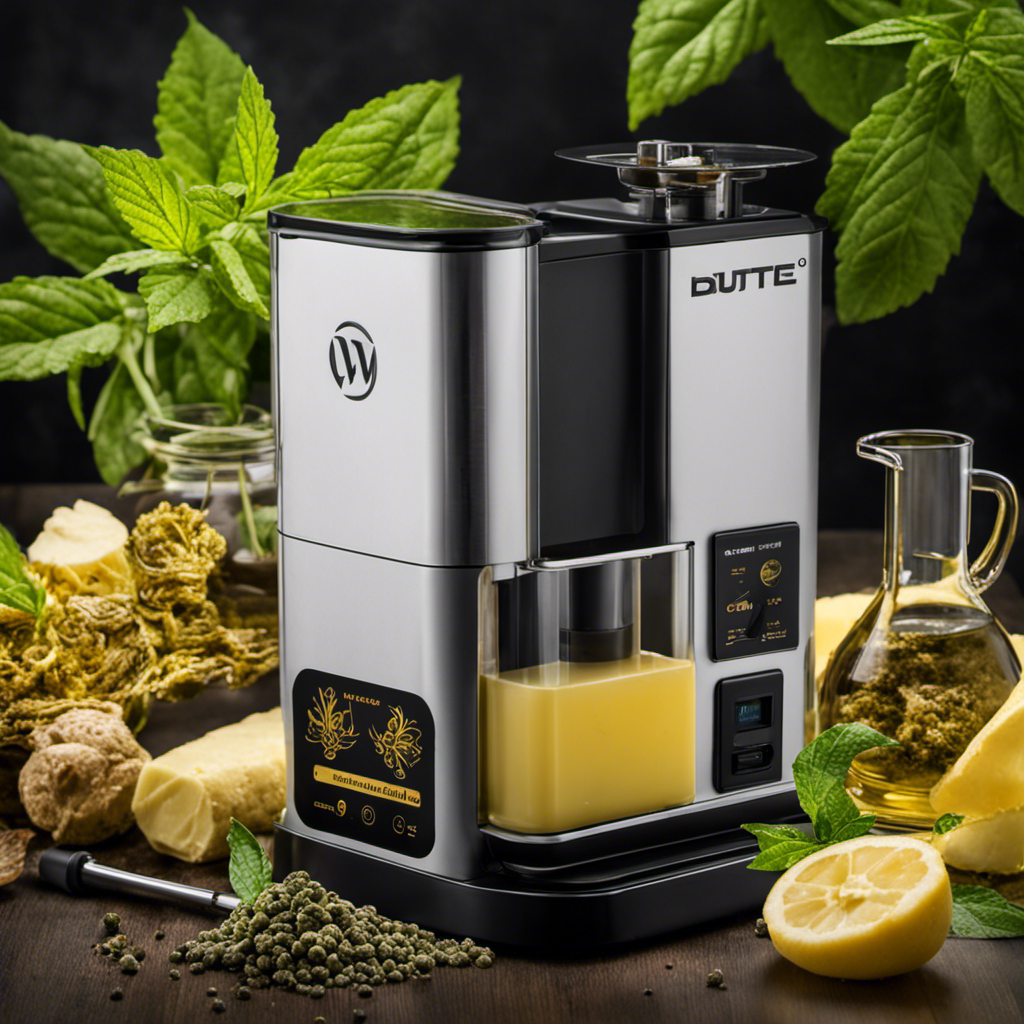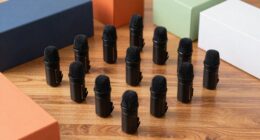I’ve always had a passion for baking, yet there remains one challenge that always seems to stump me: converting measurements from sticks to cups. It feels like an enigma that I just can’t seem to crack.
That’s why I’ve decided to dive deep into the world of butter measurements and figure out once and for all how many cups are in 2 sticks of butter. Join me on this journey as we unravel the mystery and learn the ins and outs of accurate butter measurements in baking.
Key Takeaways
- One stick of butter is equivalent to half a cup or 8 tablespoons.
- Converting sticks of butter to cups: divide the number of sticks by 2.
- Using weight measurements provides more accuracy than cups.
- Adjusting recipes requires knowing alternative butter measurements.
The Importance of Accurate Measurements in Baking
Accurate measurements are crucial in baking to ensure the perfect outcome. As a passionate baker, I understand the importance of precise measurements in creating delicious treats. Whether it’s measuring flour, sugar, or butter, each ingredient plays a vital role in achieving the desired texture and taste.
When it comes to measuring butter, there are a few tips to ensure accuracy. First, use a kitchen scale to weigh the butter in grams or ounces. This method guarantees the most precise measurement. If a scale is not available, you can also use the markings on the butter wrapper to determine the amount. Each stick of butter is equivalent to half a cup or 8 tablespoons.
Understanding Butter Measurements in Recipes
To accurately measure butter in recipes, it’s essential to understand the conversion between sticks and cups. However, not all countries use the same measurements, and some may not even have butter sold in stick form.
So how can you measure butter without sticks? One option is to use a kitchen scale to weigh the desired amount of butter in grams or ounces. Another option is to use the markings on the wrapper of the butter, which typically indicate tablespoon measurements.
If you are working with an international recipe that calls for butter in cups, you can easily convert sticks of butter to cups. For every stick of butter, which is usually 1/2 cup or 8 tablespoons, you can simply multiply the number of sticks by 1/2 to get the equivalent in cups.
Converting Sticks of Butter to Cups: a Basic Guide
When it comes to measuring butter in recipes, understanding the equivalency between sticks of butter and cups is crucial.
This guide aims to simplify the process of converting sticks of butter to cups, making it easier for home cooks to follow recipes accurately.
With a few simple formulas and measurements, you can confidently convert butter measurements and ensure your baked goods turn out just right.
Butter Measurement Equivalency
There’s a simple way to convert sticks of butter to cups. One stick of butter is equal to 1/2 cup or 8 tablespoons. This measurement is consistent across most recipes in North America. It’s helpful to know this conversion because some recipes may call for butter in cups rather than sticks.
Using the correct measurement ensures that your baked goods turn out just right. When measuring butter, it’s important to remember that precision is key. Using too much or too little can greatly affect the outcome of your recipe.
Ease of Conversions
Converting butter measurements can be a breeze with this simple equivalency.
When it comes to converting butter to grams, it’s important to know that one stick of butter, which typically weighs 113 grams, is equivalent to 8 tablespoons. This means that each tablespoon of butter is approximately 14 grams.
Whether you’re following a recipe that uses grams or tablespoons, this conversion can save you time and effort. If you need to convert butter to tablespoons, simply divide the number of grams by 14 to get the equivalent measurement in tablespoons.
It’s always helpful to have this equivalency in mind when cooking or baking, as it allows for easy adjustments and ensures accurate results.
The Standard Measurement for a Stick of Butter
I remember the first time I tried to follow a recipe that called for a stick of butter. I stood in my kitchen, holding the butter package and wondering how much exactly was in that stick.
It was then that I realized the importance of knowing the standard measurement for a stick of butter and how to convert butter measurements. In this discussion, I will explore the butter stick equivalents and provide a guide on converting butter measurements to help you navigate through your baking adventures with ease.
Butter Stick Equivalents
One stick of butter is equal to half a cup. When it comes to baking and cooking, it’s important to have accurate measurements. But what if you don’t have a stick of butter on hand? Don’t worry, there are butter substitutes available that can be measured out just as easily.
Here are some of the best tools for measuring butter:
-
Measuring cups: These are essential for measuring any ingredient, including butter. Make sure to use a liquid measuring cup for accurate results.
-
Kitchen scale: If you want to be precise, a kitchen scale is your best bet. Simply weigh out the desired amount of butter.
-
Butter dish with markings: Some butter dishes have measurements marked on the side, allowing you to easily slice off the desired amount.
-
Butter wrappers: Each stick of butter is typically wrapped in parchment paper with markings indicating tablespoon and cup measurements.
With these tools, you can confidently measure out your butter substitutes and ensure your recipes turn out just right.
Converting Butter Measurements
Using a kitchen scale is the most precise method for accurately measuring butter. When it comes to converting butter to grams or dealing with butter measurement conversions in international recipes, a kitchen scale will give you the most accurate results. Converting butter to grams is essential when following recipes from different countries, as they often use the metric system.
How to Measure Butter When You Don’t Have Sticks
When you don’t have sticks of butter, it’s helpful to know alternative ways to measure it. Here are some methods you can use:
-
Using a kitchen scale: Weighing the butter can be the most accurate way to measure it. Simply place a bowl on the scale, set it to zero, and add the desired amount of butter.
-
Using tablespoons: One stick of butter is equal to 8 tablespoons. If your recipe calls for half a stick, you can measure out 4 tablespoons instead.
-
Using a measuring cup: If you have a solid block of butter, you can measure it by using a measuring cup with markings for both cups and ounces. Just cut off the desired amount and place it in the cup.
-
Using water displacement: Fill a liquid measuring cup with 1 cup of water. Add small pieces of butter until the water level rises to the desired measurement.
These alternative methods can come in handy when you find yourself without sticks of butter but still need to measure it accurately for your recipe.
Tips for Successfully Measuring Butter in Recipes
To measure butter accurately in recipes, you should always make sure to use the correct measuring tools and techniques. When it comes to measuring butter without a scale, you can use the handy table below as a guide. It shows the equivalent measurements for butter in cups, tablespoons, and teaspoons, based on the number of sticks.
| Sticks of Butter | Cups | Tablespoons | Teaspoons |
|---|---|---|---|
| 1 | 1/2 | 8 | 24 |
| 2 | 1 | 16 | 48 |
| 3 | 1 1/2 | 24 | 72 |
| 4 | 2 | 32 | 96 |
| 5 | 2 1/2 | 40 | 120 |
Additionally, if you’re looking for tips on using butter substitutes in your recipes, consider using spreads made from vegetable oils or margarine. These substitutes can be measured in the same way as regular butter, following the measurements in the table. Just keep in mind that the taste and texture might be slightly different, so it’s always a good idea to do a taste test before using them in your final dish.
Common Baking Measurements and Conversions
When it comes to baking, getting the butter to cup ratio just right is crucial. The accurate measurement conversions can make or break a recipe, so it’s important to understand how to convert various measurements.
In this discussion, I will delve into the butter to cup ratio and provide helpful tips on accurate measurement conversions to ensure your baked goods turn out perfectly every time.
Butter to Cup Ratio
You can easily convert sticks of butter to cups using a simple ratio. When it comes to baking, knowing how much butter you need in cups instead of sticks can be helpful. Here’s how to do it:
- The standard butter ratio is 1 stick is equal to 1/2 cup.
- To convert sticks to cups, divide the number of sticks by 2.
- For example, if a recipe calls for 4 sticks of butter, you would divide 4 by 2 to get 2 cups.
- Similarly, if a recipe asks for 2 sticks of butter, you would divide 2 by 2 to get 1 cup.
Knowing this butter ratio and conversion can make following recipes much easier. So next time you’re in the kitchen, you can confidently convert sticks of butter to cups without any hassle.
Accurate Measurement Conversions?
Now that we understand the butter to cup ratio, let’s talk about the importance of precise measurements in cooking. Accurate measurements are crucial in achieving the desired outcome of a recipe. Whether it’s baking a cake or making a savory dish, the right measurements ensure that the flavors and textures come together perfectly.
To illustrate this point, let’s consider the impact of inaccurate measurements on recipe outcomes. I’ve created a table below to showcase some common ingredients and their measurements:
| Ingredient | Accurate Measurement (in cups) | Inaccurate Measurement (in cups) |
|---|---|---|
| Flour | 1 | 1.5 |
| Sugar | 0.5 | 0.3 |
| Milk | 0.25 | 0.2 |
| Butter | 0.5 | 0.7 |
| Salt | 0.1 | 0.15 |
As you can see, even small variations in measurements can significantly impact the final result. Using too much flour can make a cake dense, while too little sugar can make it taste bland. It’s crucial to follow precise measurements to ensure consistent and delicious outcomes in your cooking endeavors.
Using Cups Instead of Sticks: Pros and Cons
Using cups instead of sticks has both pros and cons. When it comes to measuring butter, using weight measurements can provide more accuracy than relying on cups. Here are some alternatives to using cups for butter measurements:
-
Electronic kitchen scale: This handy device allows you to measure butter in grams or ounces, ensuring precise measurements every time.
-
Butter sticks with measurement markings: Some brands offer butter sticks with markings indicating tablespoons or cups, making it easier to measure without using additional tools.
-
Measuring by weight: Many recipes provide weight measurements for butter, which can be more reliable and consistent than using cups.
-
Conversion charts: Online resources or kitchen reference books provide conversion charts that allow you to easily convert between cups and weight measurements.
Adjusting Recipes When Using Different Butter Measurements
When adjusting recipes for different butter measurements, it’s important to consider the weight conversions for accurate results. Sometimes, a recipe may call for a specific amount of butter in sticks, but you only have butter in a different form, such as cups or grams.
In these cases, you need to know the alternative butter measurements to ensure your recipe turns out as intended.
To adjust recipe measurements, you can use a conversion chart or online calculator to determine the equivalent amount of butter in the desired form. For example, if a recipe calls for 1 stick of butter and you only have butter in cups, you’ll need to know that 1 stick is equal to 1/2 cup.
Expert Advice on Measuring Butter Accurately
To accurately measure butter, make sure you have the appropriate measuring tools such as a kitchen scale or measuring spoons. Measuring butter substitutes can be tricky, but with these tips, you’ll be able to convert measurements effortlessly.
-
Use a kitchen scale: Weighing butter substitutes ensures precise measurements, especially when the recipe calls for ounces or grams.
-
Convert using ratios: If a recipe calls for butter, but you’re using a substitute like margarine or oil, use a conversion ratio. For example, if the recipe calls for 1 cup of butter, use 1 cup of margarine or 3/4 cup of oil.
-
Adjust for moisture content: Butter substitutes may have different moisture levels, so consider adjusting the amount accordingly. If the substitute has more moisture, reduce the quantity slightly.
-
Experiment with taste and texture: Butter substitutes can alter the flavor and texture of your recipe, so experiment and adjust the quantity to achieve the desired results.
Faqs About Converting Butter Measurements
One common question is how to accurately convert measurements for different types of butter substitutes. When it comes to baking, measuring butter accurately is crucial for achieving the desired outcome in your recipes. Here are some frequently asked questions about butter measurement conversions and some tips to help you measure butter accurately.
One question that often arises is how to convert the measurement of butter from sticks to cups. The general rule of thumb is that one stick of butter is equal to 1/2 cup or 8 tablespoons. So if a recipe calls for 1 cup of butter, you would need 2 sticks. However, it is important to note that different brands may have slightly different measurements, so always refer to the packaging for accurate conversions.
Another common question is how to measure butter when it is in a block or a tub. To measure butter from a block, use a sharp knife to cut off the desired amount, ensuring that the edges are straight for a precise measurement. For butter in a tub, you can use a measuring spoon or a kitchen scale to measure the required quantity.
Frequently Asked Questions
How Many Tablespoons Are in a Stick of Butter?
A stick of butter typically contains 8 tablespoons. This is useful to know when following a recipe that calls for butter in tablespoons. As for using whipped butter instead of regular butter, it may affect the texture and consistency of your dish.
Can I Use Margarine Instead of Butter in a Recipe?
Using margarine instead of butter in a recipe can be a viable option. Margarine is a butter substitute made from vegetable oils and offers a lower saturated fat content. However, keep in mind that the taste and texture might differ slightly. Other alternatives to butter in recipes include coconut oil, olive oil, and applesauce.
Is There a Difference in Measurement Between Salted and Unsalted Butter?
There is a difference in measurement between salted and unsalted butter. The salted variety has a stronger flavor, which can affect the taste of baked goods. It’s important to adjust the amount of salt in the recipe accordingly.
Can I Substitute Oil for Butter in a Recipe?
Yes, you can substitute oil for butter in baking. However, keep in mind that the texture and flavor of the final product may be affected. Butter adds richness and moisture to cookies, while oil may result in a slightly different outcome.
How Can I Accurately Measure Butter Without a Scale or Measuring Cup?
When I need to measure butter without a scale or measuring cup, I rely on alternative butter measurements. Converting butter from grams to cups is a helpful technique that ensures accurate measurements in my recipes.
Conclusion
In conclusion, accurately measuring butter is crucial for successful baking. This article has provided a basic guide on converting sticks of butter to cups, as well as alternative methods for measuring butter when you don’t have sticks.
It also discussed the pros and cons of using cups instead of sticks and offered expert advice on measuring butter accurately.
By understanding the importance of precise measurements and following the tips shared here, you can ensure that your baked goods turn out perfectly every time.
